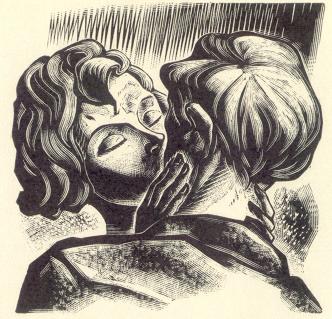The Girl : IMAGE 44 : The Kiss
Throughout Vertigo, Ward relies upon sequences of medium sized Images (3 ½" x 2") to impart evenness of narrative tone and continuity to an expository passage.2 He also uses image size to communicate tense. (For example, "The Boy" section begins with an uninterrupted sequence of sixteen medium sized blocks, whose homogeneity reinforces the idea that we are looking at past events.) Here, by using two small images in sequence—I43-I44—Ward sustains the emotional magnitude of the present moment, which, by contrast with the social and political orientation of the larger blocks, telescopes out of the temporal flow of the narrative. In the way of blissful moments in traditional narratives, they seem to stop time.
By reversing perspectives, so that the figures exchange relative positions within the stable frame of the respective images, The Boy and The Girl appear to be superimposed upon each other. Together they form a harmony, a whole. The couplet suggests the spiritual marriage of Boy and Girl, which the visual details corroborate as well as complicate. The sensuous, swan-like, curve of The Girl’s neck in I43 confers sensuality upon The Boy’s neck in I44, an effect magnified by the positioning of The Girl’s hands. A desirable creature, The Girl is also a creature of desire. Crucial subtleties emerge from a comparison of these paired images. (Even when images are not homologous, the repetition of like-sized images within the context of Ward’s multi-sized graphic approach prompts the reader to draw comparisons.) The Girl’s rapture, denoted by her closed eyes, contrasts with The Boy’s cautious, appraising, gaze; her petite shoulders contrast with his broad ones; her bold embrace contrasts with the daintiness with which previously she offers her hand. The oppositions put into play by I44can be understood as a set of complementary characteristics, further serving the narrative point that The Boy and The Girl complete each other, spiritually and physically.
Note on technique: Ward’s technical virtuosity can be seen in the various methods he applies to setting off figure from ground. Engravers since the advent of wood engraving by Thomas Bewick have relied upon outlining the figure with a fine white line, a convention Ward rarely employs. In I35, he cuts gestural, curvy white and black lines to project The Girl from the background while highlighting her curvaceous neck, a technique he repeats in I32, where the contoured lines trace The Girl’s hip and flowing dress. Often he will gouge out a section of the block surrounding the figure to create the illusion that the figure is being bathed in light, (see, for example, I41 and I42), or use a chiaroscuro technique of shaping the figure by placing it directly against a black background (see I45). Ward’s improvisations are never mechanical; they wholly depend on the effect he wants his image to achieve. In I44, his use of a thick outline to delineate The Boy’s left side implies physical solidity and by extension, reliability, legitimacy. They serve the novel’s need for characterization. With a minimum of exposition, Ward gives his readers to know that The Boy is purposeful and dependable, someone The Girl can trust.
Print view

